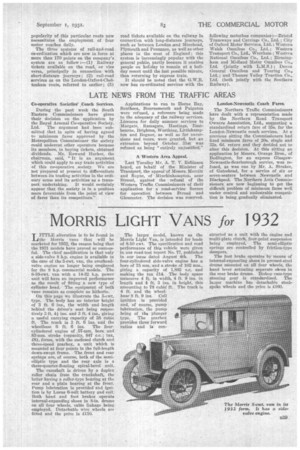MORRIS LIGHT VANS for 1932 J ITTLE alteration is to he
Page 57

If you've noticed an error in this article please click here to report it so we can fix it.
found in 4 the Morris vans that will be marketed for 1932, the reason being that the 1931 models have proved so successful. The chief modification is that only a side-valve 8 h.p. engine is available in the ease of the 5-ewt, van, the overheadvalve engine no longer being employed for the 8 h.p. commercial models. The 8-10-cwt. van with a 14-32 h.p. power • unit will have an improved performance as the result of fitting a new type of cylinder head_ The equipment of both vans remains as complete as hitherto. On this page we illustrate the 5-cwt. type. The body has an interior height of 2 ft. 6 ins., the width and length behind the driver's seat being respectively 3 ft. O, ins. and 3 ft. 4 ins., giving a useful carrying capacity of 38 cubic ft. The, track is 3 ft. 6 ins, and the wheelbase 6 ft. 6 ins. The fourcylindered engine of 57-mm. bore and 88-mm. stroke (capacity, 847 c.c.; tax, £8), forms, with the enclosed clutch and three-speed gearbox, a unit which is mounted at four points in the full-length down-swept frame. The front and rear springs are, of course, both of the semielliptic type and the rear axle is a three-quarter-floating spiral-bevel unit.
The camshaft is driven by a duplex roller chain from the crankshaft, the latter having a roller-type bearing at the rear and a plain bearing at the front. Pump lubrication is provided and ignition is by Lucas 6-volt battery and coil. Both hand and foot brakes operate internal-expanding shoes in 8-in, drums on all four wheels, cable linkage being employed. Detachable wire wheels are fitted and the price is £110.
The larger model, known as the Morris Light Van, is intended for loads of 8-10 ewt. The specification and road performance of this vehicle were given in our road-test report No. 77, pnblished in our issue dated August 4th. The four-cylindered side-valve engine has a bore of 75 mm. and a stroke of 102 inm., giving a capacity of 1,802 c.c. and making the tax £14. The body space measures 4 ft. in width, 4 ft. 9 ins, in length and 4 ft. 3 ins, in height, this amounting to 78 cubic. ft. The track is 4 ft. and the wheelbase 8 ft. 9 ins. Coil ignition is provided and, of course, pump lubrication, the pump being of the plunger type. The gearbox provides, three forward ratios and is con
structed as a unit with the engine and multi-plate clutch, four-point suspension being employed. The semi-elliptic springs are controlled by friction-type dampers.
The foot brake operates by means of internal-expanding shoes in pressed-steel drums mounted on all four wheels, the hand lever actuating separate shoes in the rear brake drums. Bishop cam-type steering gear is standardized. The larger machine has detachable steelspoke wheels and the price is £160.




































































































